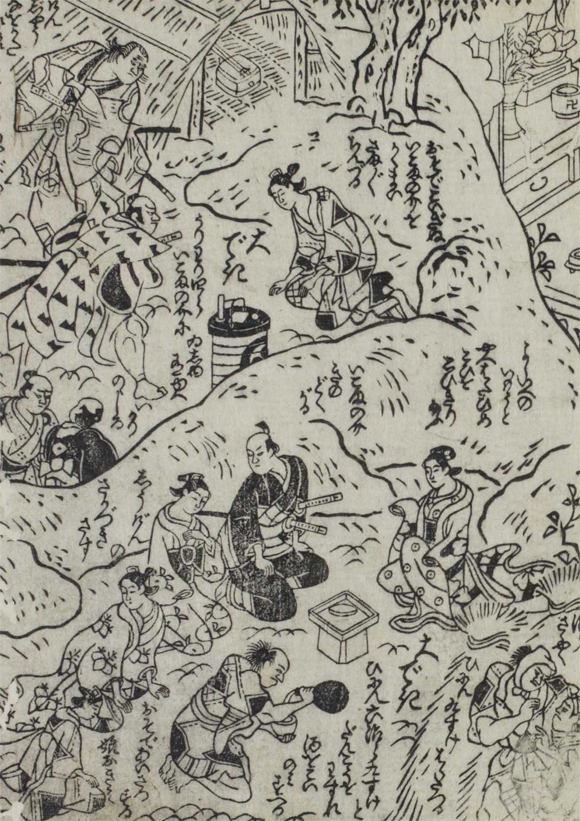| SHUSHAKA ZUTSUMI |
| Play title | ďshű Adachi-ga-Hara |
| Common title | Shushaka Zutsumi |
| Authors | Chikamatsu Hanji Takeda Izumi Kitamado Goichi Takemoto Saburobŕ II |
| History |
Chikamatsu Hanji's play in five acts "ďshű Adachi-ga-Hara" was originally written for the puppets theater in 1762. It was adapted for Kabuki in the 2nd lunar month of 1763 and staged at the Moritaza [casting|illustrations]. The historical background of this play is the zenkunen war, which opposed the Abe clan, ruler of the northern provinces of Japan (ďshű), to the Minamoto clan. The latter clan, led by Minamoto no Yoriyoshi and his son Minamoto no Yoshiie, defeated the former clan, led by Abe no Yoritoki and his two sons, Abe no Sadat˘ and Abe no Munet˘. After the war, the two sons became fugitives and the play is about their actions and their last murder attempts against their victor. The playwrights also integrated within this drama two famous ďshű legends, the ogress of Adachi-ga-Hara and the ut˘ bird. The "Shushaka Zutsumi" was staged only 3 times since the end of WWII: in November 1979 in T˘ky˘ at the Sunshine Theatre, in February 1980 in ďsaka at the Nakaza and in April 1983 at the Meijiza. The role of Sodehagi was always played by Ichikawa Ennosuke III. |
| Structure |
"Shushaka Zutsumi" was the first scene (kuchi) of the third act of "ďshű Adachi-ga-Hara". "Shushaka Zutsumi" is rarely staged nowadays. |
| Key words |
Abe Munet˘ Abe Sadat˘ Abe-shi Abe Yoritoki Adachi-ga-Hara Gidayű Ky˘gen Hinin Jidaimono Kuchi Minamoto Yoriyoshi Minamoto Yoshiie ďshű Shichij˘ Tsutsumi Zenkunen |
| Summary |
A blind woman beggar named Sodehagi, who has apparently seen better days, lives in a hut on the Shushaka river bank near Shichij˘ in Ky˘to. She lives together with her little daughter Okimi. Uriwari Shir˘ comes to the front of the hut and asks the hinin Dobu Roku to help him arresting Ikomanosuke and his lover Koiginu. Taira Kenj˘ Naokata, another retainer of Hachiman Tar˘, in charge of finding the missing Prince Tamaki, happens to meet Princess Yaehata, Hachiman Tar˘'s younger sister, in front of Sodehagi's hut. While they are exchanging greetings, he notices the approach of Ikomanosuke and Koiginu, so he quickly goes away, leaving Princess Yaehata behind. When Princess Yaehata sees the young lovers, she tells Koiginu that she has given up Ikomanosuke. Koiginu, who is pregnant, thanks her for her generosity. She suddenly promises that she will be Ikomanosuke's wife in the afterlife. She wishes to have Ikomanosuke and Princess Yaehata hold a wedding ceremony immediately. Overhearing their conversation, Sodehagi comes out of her hut and offers her cup and some sake to enable Ikomanosuke and Princess Yaehata exchange nuptial cups of sake. Dobu Roku comes back, but instead of trying to arrest Ikomanosuke and Koiginu, he takes up the cup and drink sake to his heart's content. Hearing the approach of people, Sodehagi makes Ikomanosuke and Koiginu hide in her hut. Shir˘ and his men and Kenj˘ arrive. Shir˘ calls Sodehagi to come out of the hut. Kenj˘ immediately recognizes her as his daughter, whom he disowned when she fell in love with a man of low social status. He does not, however, identify himself to her and tells Shir˘ and his men to go away, saying that he will take over the work assigned to Shir˘. Some of Kenj˘'s retainers come to tell him that ďe Koretoki has ordered that Kenj˘ must locate Prince Tamaki in a day or two or commit suicide. As Kenj˘ hurries away, Sodehagi follows him, led by Okimi by the hand. |
 |
|
A picture for "Shushaka Zutsumi" from the ezukushi banzuke for the staging in the 9th lunar month of 1762 in ďsaka at the Takemotoza of the puppet play "ďshű Adachi-ga-Hara" |
|
|
| Contact | Main | Top | Updates | Actors | Plays | Playwrights | Programs | Links | FAQ | Glossary | Chronology | Illustrations | Prints | Characters | Derivatives | Theaters | Coming soon | News |